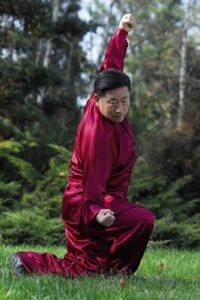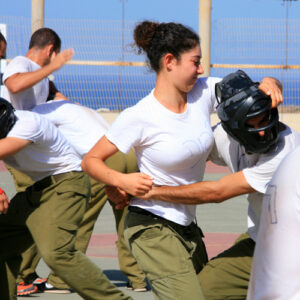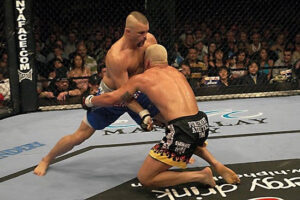If you’re on the journey of martial arts mastery, which is ultimately a spiritual one, it’s probably worth knowing the common mistakes that so-called masters don’t realise they’re making.
But before we start: what qualifies me to tell a master what he’s doing wrong? Well: nothing. You’re welcome to call me a fraud. But if you’re open-minded, feel free to read on, and see if you notice the things I’m talking about when watching the so-called masters in action.
Over-reaching – curse of Wing Chun

In styles with abundance of technical quality, for example Wing Chun Kung Fu, I see ‘masters’ making this mistake all the time. They focus on their one opponent at the sacrifice of all-round full-body balance. If you have both your arms facing the same direction, and both are stretched out side by side, you’re going to be the laughing stock of the fight. Nobody does that, but many experienced stylists follow their teachers’ mistakes when they do something similar – they stretch one or both of their hands a little too far in the direction of their opponent at 12 o’clock, with no bent elbow awaiting the potential on-coming force from 3 o’clock, no centralised arms ready to defend from the guy behind you (on your 6 o’clock or at 9 o’clock). When you’re visualising one-on-one, and you have a fancy posture, it’s easy to think your moves are perfect, forgetting the potential surprise barge attack from another direction which could send you tumbling into a mess where you may then have no guard whatsoever.
Lack of practical focus – curse of Tai Chi, Karate, Taekwondo…

There is a severe case of delusion throughout the world in standard classes of Tai Chi, Karate, Taekwondo, and most other ‘traditional’ martial arts that are not tested with at least some kind of competitive exercises not bogged down by strict rules.
In contrast to over-reaching / hyperfocus / ‘tunnel-vision-induced delusion’ as we’ve just highlighted in Wing Chun; we’re now talking about the opposite – that’s the severe lack of practical focus on applications of techniques – a serious under-focus due to lack of genuine technical intricacy. A fluffy tai chi master, for example, usually doesn’t have a clue of the practical applications of his subtle movements. He will practice solo all day and be graceful when nobody’s pushing him from behind or from the side, but with one unexpected push he is usually the first to fall over. Not all teachers are the same. But these fluffy fancy styles are usually full of teachers who literally haven’t a clue what they’re doing – it’s 90% for show – and when they touch hands with you they will probably be as open as a book – very easy to hit and useless at defending.
The typical self-described Tai Chi master may have a deluded sense of practicality, but there are some true masters of Tai Chi in the world with really great moves up their sleeves (although they may be hard to find, living in the rural Far East – I’m not talking about the so-called leaders of the classical Yang & Chen style system, I’m talking about people who’ve somewhat more disassociated themselves from such bad-habit-ridden systems).

Karate and Taekwondo, in theory, are not much different to Tai Chi in this respect. They too are ridden with ‘masters’ who lack practical applications. Most schools of these styles are rather void of truly balanced techniques, but there are some true masters out there within these styles. But Karate and Taekwondo are much more commercially promoted. Tai Chi is mainly promoted as a healthy exercise, where as Karate and Taekwondo are far more heavily promoted and are meant to be more for fighting.
50% of people who go to Karate and Taekwondo (TKD) clubs have kind of cottoned on to the impracticality of their moves to some extent – they just train for the workout, to keep fit. TKD classes are especially energetic, with so many wild jumping kicks.
Dazed aggression – curse of Krav Maga

Great fighters are not hot-headed. If you can’t calm your aggression and control your energy gracefully, you are not a true master of martial art. Styles like Israeli Krav Maga teach aggression as the core of their style. It’s not real skillful fighting though. The actual moves are very amateurish. There’s no room to perfect the technique when your practice session is so hot-headed. The whole point of mastering martial techniques is to perfect them before the fight, so that you can make best use of them during the fight. But approaching the training aggressively is only going to cause friction in your mind – a blockage in your learning experience – a barrier to taking onboard new concepts because your mind is in a no-compromise mentality. If you really aim to be a great martial artist, try something calmer, like tai chi. It might look fluffy, and it often is, but at least you won’t be making this particular mistake – wild aggression – the worst mistake a martial artist can make. So save the fluff bashing for another day, and calm your mind in a Tai Chi or Aikido class instead of burning it up in a mind-bashing Krav Maga session for example.
Lack of ‘strike’ – curse of MMA

MMA has a lot of wrestling and a lot of sporty strike exchanges, but MMA culture is generally fearful of fully-loaded striking. Even though they do boxing and Muay Thai, most MMA practitioners follow tournament rules in their training – they avoid kicks to the groin, and are happy to take low wrestling stances because they don’t expect their opponent to kick them between the legs. They get in close and grapple because their opponent doesn’t punish them as a good striker would. The whole point of a strike is that you feel struck by it. When a wrestler tries to close the range, he gets a KO. That’s how to stop a wrestler from wrestling you. That’s how to finish a MMA fight in a second. Striking is seriously underplayed in sport-style martial arts. If you approached a really good striker, you would get within a certain range and then be punished every time you tried to get any closer than that boundary. A real strike is in the best case a fight ender, and in the worst case it stops an opponent getting close enough to wrestle. This is extremely rarely seen in MMA. A bit more common in Western Boxing and Muay Thai because they’re generally better strikers than the big UFC ‘wrestlers’, but still when you’re wearing gloves the effect is heavily muffled. An ever-ready strong set of knuckles to the solar plexus (central lower chest) is enough to keep a man at a distance in a real fight. That’s ideal for when he’s trying to grab you – perhaps he’s a Judoka or a wrestler. You can’t wrestle a good striker – you’ll never get close enough.